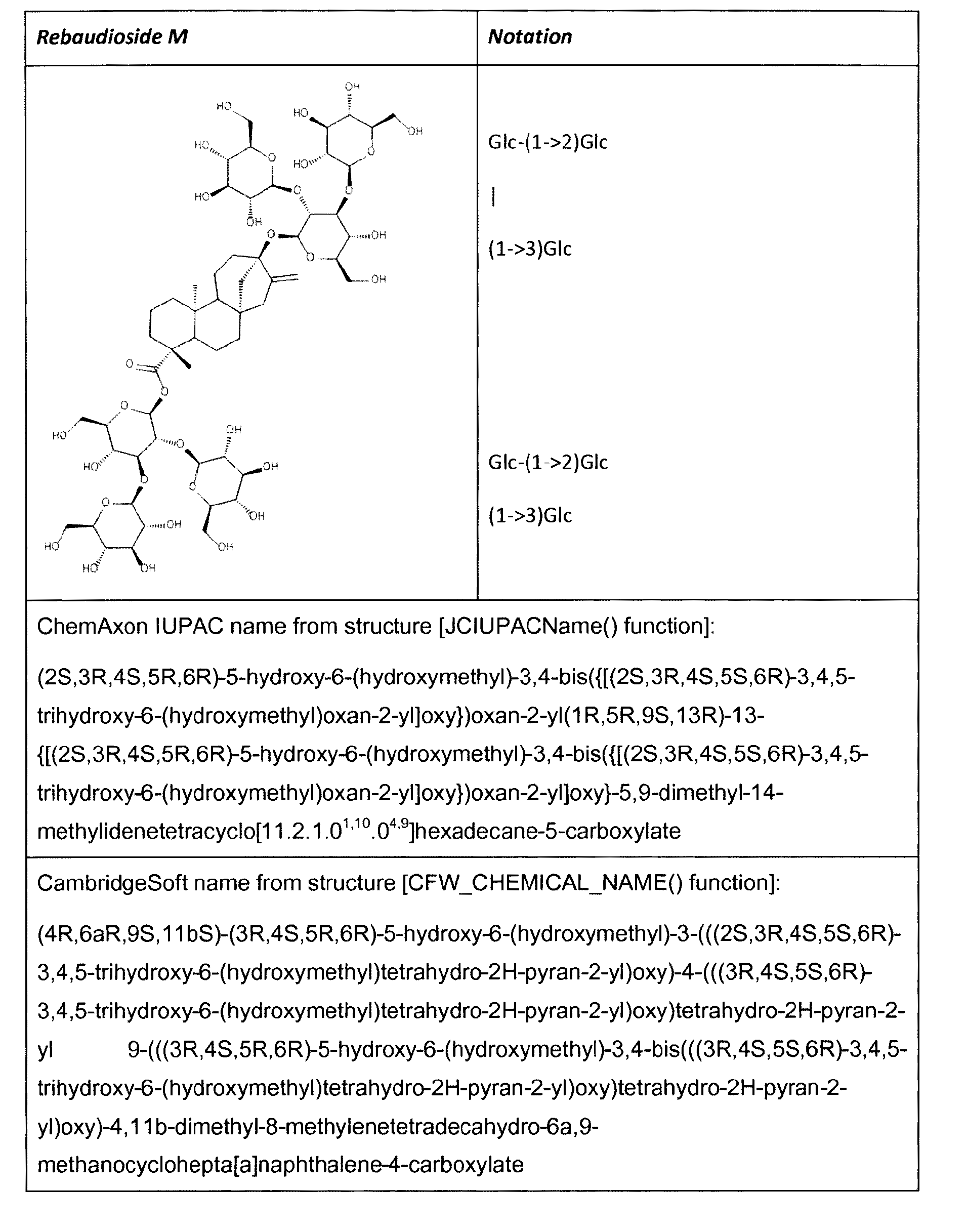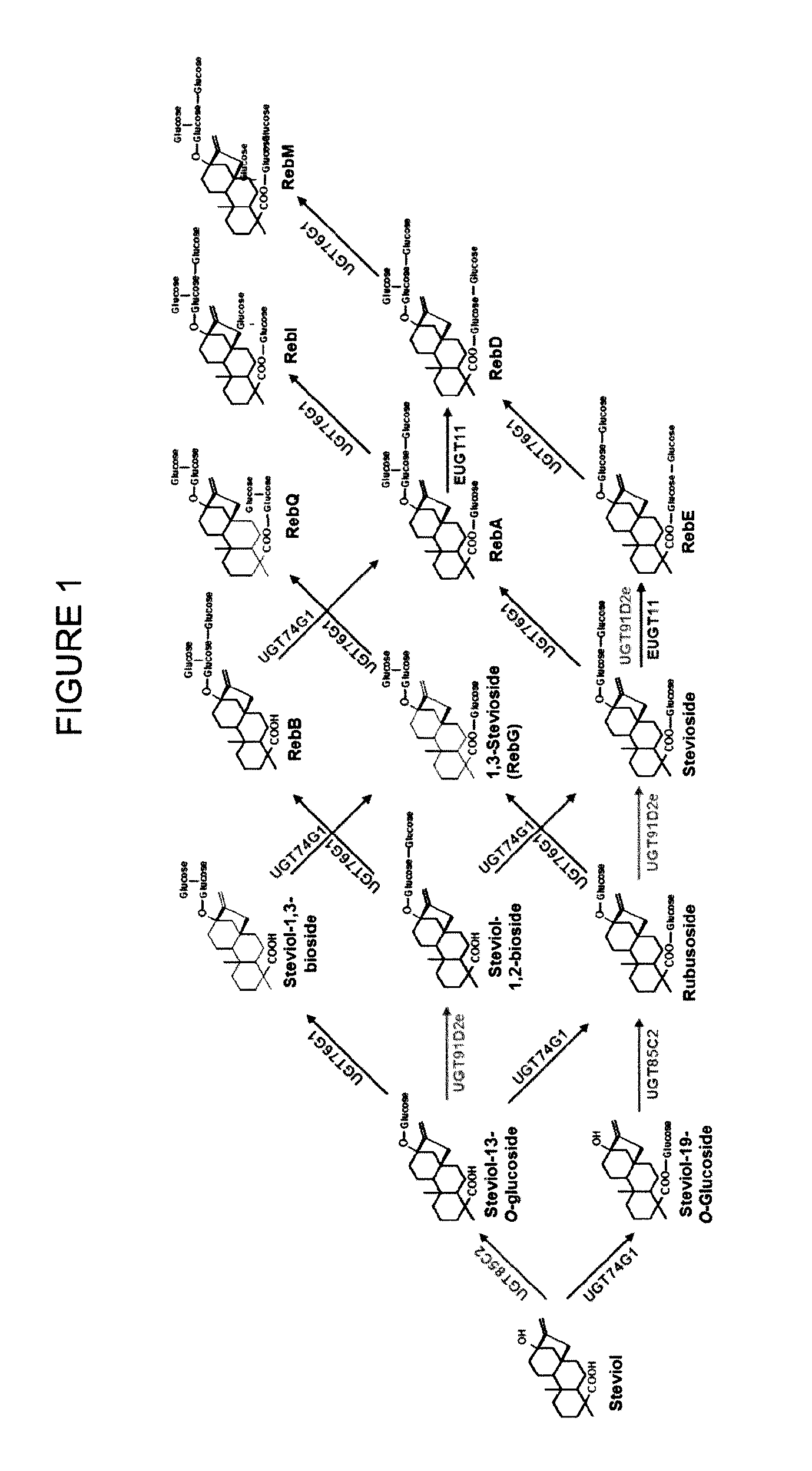Methods for improved production of rebaudioside d and rebaudioside m
a technology of rebaudioside m and rebaudioside d, which is applied in the field of rebaudioside m recombinant production, can solve the problems of more or less problematic contamination, and achieve the effect of improving the formation rate of rebaudioside m and specificity/activity
- Summary
- Abstract
- Description
- Claims
- Application Information
AI Technical Summary
Benefits of technology
Problems solved by technology
Method used
Image
Examples
example 1
Strain Engineering and Fermentation of EFSC 3044
[0372]Yeast strain EFSC 3044 was derived from a wild type Saccharomyces cerevisiae strain containing three auxotrophic modifications, namely the deletions of URA3, LEU2 and HIS3. The strain can be manipulated using standard genetic methods and can be used as a regular diploid or haploid yeast strain. The strain was converted to steviol glycosides-producing yeast by genomic-integration of five DNA constructs. Each construct contained multiple genes and was introduced into the yeast genome by homologous recombination. Furthermore, the first, second, and fifth construct were assembled by homologous recombination in yeast.
[0373]The first construct contained eight genes and was inserted in the DPP1 locus and disrupted and partially deleted DPP1 (phosphatase). The DNA inserted contained: the Ashbya gossypii TEF1 promoter expressing the natMX gene (selectable marker) followed by the TEF1 terminator from A. gossypii; Gene Art codon optimized S...
example 2
In Vitro Characterization of Reactions that Produce a Hexa-Glycosylated Steviol Glycoside
[0385]As described in Example 1, a hexa-glucosyl steviol glycoside was observed when EUGT11 was expressed at high levels in steviol-glycoside producing yeast strains. To characterize the reactions that were occurring to produce this molecule, further in vitro work was done with individual UGTs.
[0386]UGT76G1 (SEQ ID NO: 1) was cloned into the pET30a plasmid (EMD Millipore). The resulting vector was transformed into an appropriate DE3 E. coli strain and transformants were grown and induced according to manufacturer's protocols. The corresponding fusion protein (6×HIS-tagged) was purified by immobilized metal affinity chromatography using standard methods.
[0387]Approximately 0.08 μg of purified UGT76G1 per μL of reaction was incubated with 100 μM RebD, 300 μM UDP-glucose, and 10 U / mL Alkaline Phosphatase (Fermentas / Thermo Fisher, Waltham, Mass.). The reactions were performed at 30° C. in 20 mM Hepe...
example 3
Isolation of the Hexa-Glycosylated Molecule
[0389]The hexa-glucosyl steviol glycoside product was isolated from a fermentation similar to that described in Example 1 for structural analysis following the scheme outlined in FIG. 6.
[0390]After the fermentation, the culture broth was centrifuged for 30 min at 7000 rpm at 4° C. and the supernatant was purified as follows: A glass column was filled with 150 mL HP20 Diaion® resin (Supelco), and an aliquot of 300 mL supernatant was loaded on to the column and washed with 2×250 mL MilliQ water. The glycoside product was eluted by stepwise incremental increases in the methanol concentration in MilliQ water (in 250 mL portions—starting with 0%→10%→40%→60%→80%→100% MeOH). The levels of steviol glycosides in each fraction were analyzed by LC-MS. The most promising fractions (60-80% MeOH) were combined and reduced to total of 10 mL using a vacuum evaporator. A glass column filled with 600 mL spherical C18 bonded flash silica gel (45-70 um, 70 Å / S...
PUM
| Property | Measurement | Unit |
|---|---|---|
| Fraction | aaaaa | aaaaa |
| Fraction | aaaaa | aaaaa |
| Fraction | aaaaa | aaaaa |
Abstract
Description
Claims
Application Information
 Login to View More
Login to View More - R&D
- Intellectual Property
- Life Sciences
- Materials
- Tech Scout
- Unparalleled Data Quality
- Higher Quality Content
- 60% Fewer Hallucinations
Browse by: Latest US Patents, China's latest patents, Technical Efficacy Thesaurus, Application Domain, Technology Topic, Popular Technical Reports.
© 2025 PatSnap. All rights reserved.Legal|Privacy policy|Modern Slavery Act Transparency Statement|Sitemap|About US| Contact US: help@patsnap.com



